Isotretinoin: Difference between revisions
No edit summary |
No edit summary |
||
| Line 274: | Line 274: | ||
Some patients undergoing vigorous physical activity while on isotretinoin therapy have experienced elevated CPK levels; however, the clinical significance is unknown. There have been rare postmarketing reports of rhabdomyolysis, some associated with strenuous physical activity. In an isotretinoin clinical trial of 924 patients, marked elevations in CPK (≥350 U/L) were observed in approximately 24% of patients. In another clinical trial of 217 pediatric patients (12 – 17 years) elevations in CPK were observed in 12% of patients, including those undergoing strenuous physical activity in association with reported musculoskeletal adverse events such as back pain, arthralgia, limb injury, or muscle sprain. In these patients, approximately half of the CPK elevations returned to normal within 2 weeks and half returned to normal within 4 weeks. No cases of rhabdomyolysis were reported in this clinical trial. | Some patients undergoing vigorous physical activity while on isotretinoin therapy have experienced elevated CPK levels; however, the clinical significance is unknown. There have been rare postmarketing reports of rhabdomyolysis, some associated with strenuous physical activity. In an isotretinoin clinical trial of 924 patients, marked elevations in CPK (≥350 U/L) were observed in approximately 24% of patients. In another clinical trial of 217 pediatric patients (12 – 17 years) elevations in CPK were observed in 12% of patients, including those undergoing strenuous physical activity in association with reported musculoskeletal adverse events such as back pain, arthralgia, limb injury, or muscle sprain. In these patients, approximately half of the CPK elevations returned to normal within 2 weeks and half returned to normal within 4 weeks. No cases of rhabdomyolysis were reported in this clinical trial. | ||
|clinicalTrials=The following adverse reactions with ABSORICA or other isotretinoin products are described in more detail in other sections of the labeling: | |clinicalTrials=The following adverse reactions with ABSORICA or other isotretinoin products are described in more detail in other sections of the labeling: | ||
| Line 361: | Line 360: | ||
The following adverse reactions have been reported in clinical trials conducted with isotretinoin: glomerulonephritis, nonspecific urogenital findings. | The following adverse reactions have been reported in clinical trials conducted with isotretinoin: glomerulonephritis, nonspecific urogenital findings. | ||
|postmarketing=There is limited information regarding <i>Postmarketing Experience</i> of {{PAGENAME}} in the drug label. | |postmarketing=There is limited information regarding <i>Postmarketing Experience</i> of {{PAGENAME}} in the drug label. | ||
| Line 461: | Line 459: | ||
Cases of IQ scores less than 85 with or without other abnormalities have been reported. An increased risk of spontaneous abortion and premature births have been documented with isotretinoin exposure during pregnancy. | Cases of IQ scores less than 85 with or without other abnormalities have been reported. An increased risk of spontaneous abortion and premature births have been documented with isotretinoin exposure during pregnancy. | ||
|useInPregnancyAUS=* '''Australian Drug Evaluation Committee (ADEC) Pregnancy Category''' | |useInPregnancyAUS=* '''Australian Drug Evaluation Committee (ADEC) Pregnancy Category''' | ||
| Line 523: | Line 520: | ||
If a pregnancy does occur during ABSORICA treatment, ABSORICA must be discontinued immediately. The patient should be referred to an Obstetrician-Gynecologist experienced in reproductive toxicity for further evaluation and counseling. Any suspected fetal exposure during or 1 month after ABSORICA therapy must be reported immediately to the FDA via the MedWatch number 1-800-FDA-1088 and also to the iPLEDGE pregnancy registry at 1-866-495-0654 or via the internet (www.ipledgeprogram.com) [see Warnings and Precautions (5.2)]. | If a pregnancy does occur during ABSORICA treatment, ABSORICA must be discontinued immediately. The patient should be referred to an Obstetrician-Gynecologist experienced in reproductive toxicity for further evaluation and counseling. Any suspected fetal exposure during or 1 month after ABSORICA therapy must be reported immediately to the FDA via the MedWatch number 1-800-FDA-1088 and also to the iPLEDGE pregnancy registry at 1-866-495-0654 or via the internet (www.ipledgeprogram.com) [see Warnings and Precautions (5.2)]. | ||
|administration=* Oral | |administration=* Oral | ||
| Line 558: | Line 553: | ||
<!--Pharmacokinetics--> | <!--Pharmacokinetics--> | ||
|PK= Absorption | |PK=Absorption | ||
Due to its high lipophilicity, oral absorption of isotretinoin is enhanced when given with a high-fat meal. ABSORICA is bioequivalent to Accutane® (isotretinoin) capsule when both drugs are taken with a high-fat meal. ABSORICA is more bioavailable than Accutane® (isotretinoin) capsules when both drugs are taken fasted; the AUC0-t of ABSORICA is approximately 83% greater than that of Accutane®. ABSORICA is therefore not interchangeable with generic products of Accutane®. | Due to its high lipophilicity, oral absorption of isotretinoin is enhanced when given with a high-fat meal. ABSORICA is bioequivalent to Accutane® (isotretinoin) capsule when both drugs are taken with a high-fat meal. ABSORICA is more bioavailable than Accutane® (isotretinoin) capsules when both drugs are taken fasted; the AUC0-t of ABSORICA is approximately 83% greater than that of Accutane®. ABSORICA is therefore not interchangeable with generic products of Accutane®. | ||
| Line 642: | Line 637: | ||
40 mg: Brown and red, capsule imprinted with white ink “ G 325” on cap and “ 40” on the body | 40 mg: Brown and red, capsule imprinted with white ink “ G 325” on cap and “ 40” on the body | ||
Box of 30 capsules (3 x 10 Prescription Packs): NDC10631-118-31 | Box of 30 capsules (3 x 10 Prescription Packs): NDC10631-118-31 | ||
|storage=Store at 20° C - 25° C (68° F - 77° F), excursion permitted between 15° C - 30° C (59° F - 86° F) [see USP controlled room temperature]. Protect from light. | |storage=Store at 20° C - 25° C (68° F - 77° F), excursion permitted between 15° C - 30° C (59° F - 86° F) [see USP controlled room temperature]. Protect from light. | ||
|packLabel=[[File:Isotretinoin pdp1.jpg|600px|thumbnail|left]] | |||
{{clear}} | |||
[[File:Isotretinoin pdp2.jpg|600px|thumbnail|left]] | |||
{{clear}} | |||
[[File:Isotretinoin pdp3.jpg|600px|thumbnail|left]] | |||
{{clear}} | |||
[[File:Isotretinoin pdp4.jpg|600px|thumbnail|left]] | |||
{{clear}} | |||
[[File:Isotretinoin pdp5.jpg|600px|thumbnail|left]] | |||
{{clear}} | |||
[[File:Isotretinoin pdp6.jpg|600px|thumbnail|left]] | |||
{{clear}} | |||
[[File:Isotretinoin pdp7.jpg|600px|thumbnail|left]] | |||
{{clear}} | |||
[[File:Isotretinoin pdp8.jpg|600px|thumbnail|left]] | |||
{{clear}} | |||
[[File:Isotretinoin pdp9.jpg|600px|thumbnail|left]] | |||
{{clear}} | |||
[[File:Isotretinoin pdp10.jpg|600px|thumbnail|left]] | |||
{{clear}} | |||
[[File:Isotretinoin pdp11.jpg|600px|thumbnail|left]] | |||
{{clear}} | |||
[[File:Isotretinoin pdp12.jpg|600px|thumbnail|left]] | |||
{{clear}} | |||
[[File:Isotretinoin label.png|600px|thumbnail|left]] | |||
{{clear}} | |||
|fdaPatientInfo=Advise the patient that ABSORICA is only available through a restricted program called iPLEDGE. | |fdaPatientInfo=Advise the patient that ABSORICA is only available through a restricted program called iPLEDGE. | ||
| Line 676: | Line 711: | ||
<!--Brand Names--> | <!--Brand Names--> | ||
|brandNames= | |brandNames=Accutane, | ||
Amnesteem, | |||
Claravis, | |||
Sotret, | |||
Myorisan, | |||
Absorica. | |||
|lookAlike=* A® — B®<ref name="www.ismp.org">{{Cite web | last = | first = | title = http://www.ismp.org | url = http://www.ismp.org | publisher = | date = }}</ref> | |lookAlike=* A® — B®<ref name="www.ismp.org">{{Cite web | last = | first = | title = http://www.ismp.org | url = http://www.ismp.org | publisher = | date = }}</ref> | ||
Revision as of 14:52, 12 December 2014
Editor-In-Chief: C. Michael Gibson, M.S., M.D. [1];
Disclaimer
WikiDoc MAKES NO GUARANTEE OF VALIDITY. WikiDoc is not a professional health care provider, nor is it a suitable replacement for a licensed healthcare provider. WikiDoc is intended to be an educational tool, not a tool for any form of healthcare delivery. The educational content on WikiDoc drug pages is based upon the FDA package insert, National Library of Medicine content and practice guidelines / consensus statements. WikiDoc does not promote the administration of any medication or device that is not consistent with its labeling. Please read our full disclaimer here.
Black Box Warning
|
WARNING: CAUSES BIRTH DEFECTS
See full prescribing information for complete Boxed Warning.
BIRTH DEFECTS:
ABSORICA must not be used by female patients who are or may become pregnant [seeWarnings and Precautions (5) and Use in Specific Populations (8.1, 8.6)]. There is an extremely high risk that severe birth defects will result if pregnancy occurs while taking ABSORICA in any amount, even for short periods of time [seeWarnings and Precautions (5.1) and Use in Specific Populations (8.1)]. Potentially any fetus exposed during pregnancy can be affected [seeUse in Specific Populations(8.1)]. There are no accurate means of determining whether an exposed fetus has been affected [seeWarning and Precautions (5.1) and Use in Specific Populations (8.1)]. Birth defects which have been documented following isotretinoin exposure include abnormalities of the face, eyes, ears, skull, central nervous system, cardiovascular system, and thymus and parathyroid glands. Cases of IQ scores less than 85 with or without other abnormalities have been reported. There is an increased risk of spontaneous abortion and premature births have been reported [seeUse in Specific Populations(8.1)]. Documented external abnormalities include: skull abnormality; ear abnormalities (including anotia, micropinna, small or absent external auditory canals); eye abnormalities (including microphthalmia; facial dysmorphia; cleft palate). Documented internal abnormalities include: CNS abnormalities (including cerebral abnormalities, cerebellar malformation, hydrocephalus, microcephaly, cranial nerve deficit); cardiovascular abnormalities; thymus gland abnormality; parathyroid hormone deficiency. In some cases death has occurred with certain abnormalities previously noted [seeUse in Specific Populations (8.1)]. If pregnancy does occur during the treatment of a female patient who is taking ABSORICA, ABSORICA must be discontinued immediately and she should be referred to an Obstetrician-Gynecologist experienced in reproductive toxicity for further evaluation and counseling [seeUse in Specific Populations (8.1)]. Special Prescribing Requirements Because of the risk of teratogenicity and to minimize fetal exposure, ABSORICA is available only through a restricted program under a Risk Evaluation and Mitigation Strategy (REMS) called iPLEDGE™. Under the ABSORICA REMS, prescribers, patients, pharmacies, and distributors must enroll and be registered in the program [seeWarnings and Precautions (5.2)]. |
Overview
Isotretinoin is a {{{drugClass}}} that is FDA approved for the {{{indicationType}}} of {{{indication}}}. There is a Black Box Warning for this drug as shown here. Common adverse reactions include lip dry, dry skin, back pain, dry eye, arthralgia, epistaxis, headache, nasopharyngitis, chapped lips, dermatitis, blood creatine kinase increased, cheilitis, musculoskeletal discomfort, upper respiratory tract infection, visual acuity reduced.
Adult Indications and Dosage
FDA-Labeled Indications and Dosage (Adult)
Condition1
- Dosing Information
- Dosage
Condition2
- Dosing Information
- Dosage
Condition3
- Dosing Information
- Dosage
Condition4
- Dosing Information
- Dosage
Off-Label Use and Dosage (Adult)
Guideline-Supported Use
Condition1
- Developed by:
- Class of Recommendation:
- Strength of Evidence:
- Dosing Information
- Dosage
Condition2
There is limited information regarding Off-Label Guideline-Supported Use of Isotretinoin in adult patients.
Non–Guideline-Supported Use
Condition1
- Dosing Information
- Dosage
Condition2
There is limited information regarding Off-Label Non–Guideline-Supported Use of Isotretinoin in adult patients.
Pediatric Indications and Dosage
FDA-Labeled Indications and Dosage (Pediatric)
Condition1
- Dosing Information
- Dosage
Condition2
There is limited information regarding FDA-Labeled Use of Isotretinoin in pediatric patients.
Off-Label Use and Dosage (Pediatric)
Guideline-Supported Use
Condition1
- Developed by:
- Class of Recommendation:
- Strength of Evidence:
- Dosing Information
- Dosage
Condition2
There is limited information regarding Off-Label Guideline-Supported Use of Isotretinoin in pediatric patients.
Non–Guideline-Supported Use
Condition1
- Dosing Information
- Dosage
Condition2
There is limited information regarding Off-Label Non–Guideline-Supported Use of Isotretinoin in pediatric patients.
Contraindications
4.1 Pregnancy
ABSORICA can cause fetal harm when administered to a pregnant woman. Major congenital malformations, spontaneous abortions, and premature births have been documented following pregnancy exposure to isotretinoin in any amount and even for short periods of time. ABSORICA is contraindicated in females who are or may become pregnant. If this drug is used during pregnancy, or if the patient becomes pregnant while taking this drug, treatment should be discontinued and the patient should be apprised of the potential hazard to the fetus [seeUse in Specific Populations (8.1)].
4.2 Hypersensitivity
Hypersensitivity to this product (or Vitamin A, given the chemical similarity to isotretinoin) or to any of its components [seeWarnings and Precautions (5.14)].
Warnings
|
WARNING: CAUSES BIRTH DEFECTS
See full prescribing information for complete Boxed Warning.
BIRTH DEFECTS:
ABSORICA must not be used by female patients who are or may become pregnant [seeWarnings and Precautions (5) and Use in Specific Populations (8.1, 8.6)]. There is an extremely high risk that severe birth defects will result if pregnancy occurs while taking ABSORICA in any amount, even for short periods of time [seeWarnings and Precautions (5.1) and Use in Specific Populations (8.1)]. Potentially any fetus exposed during pregnancy can be affected [seeUse in Specific Populations(8.1)]. There are no accurate means of determining whether an exposed fetus has been affected [seeWarning and Precautions (5.1) and Use in Specific Populations (8.1)]. Birth defects which have been documented following isotretinoin exposure include abnormalities of the face, eyes, ears, skull, central nervous system, cardiovascular system, and thymus and parathyroid glands. Cases of IQ scores less than 85 with or without other abnormalities have been reported. There is an increased risk of spontaneous abortion and premature births have been reported [seeUse in Specific Populations(8.1)]. Documented external abnormalities include: skull abnormality; ear abnormalities (including anotia, micropinna, small or absent external auditory canals); eye abnormalities (including microphthalmia; facial dysmorphia; cleft palate). Documented internal abnormalities include: CNS abnormalities (including cerebral abnormalities, cerebellar malformation, hydrocephalus, microcephaly, cranial nerve deficit); cardiovascular abnormalities; thymus gland abnormality; parathyroid hormone deficiency. In some cases death has occurred with certain abnormalities previously noted [seeUse in Specific Populations (8.1)]. If pregnancy does occur during the treatment of a female patient who is taking ABSORICA, ABSORICA must be discontinued immediately and she should be referred to an Obstetrician-Gynecologist experienced in reproductive toxicity for further evaluation and counseling [seeUse in Specific Populations (8.1)]. Special Prescribing Requirements Because of the risk of teratogenicity and to minimize fetal exposure, ABSORICA is available only through a restricted program under a Risk Evaluation and Mitigation Strategy (REMS) called iPLEDGE™. Under the ABSORICA REMS, prescribers, patients, pharmacies, and distributors must enroll and be registered in the program [seeWarnings and Precautions (5.2)]. |
ABSORICA must not be used by female patients who are or may become pregnant. There is an extremely high risk that severe birth defects will result if pregnancy occurs while taking ABSORICA in any amount, even for short periods of time.
5.1 Embryofetal Toxicity
Teratogenicity
Major congenital malformations, spontaneous abortions, and premature births have been documented following pregnancy exposure to isotretinoin [seeUse in Specific Populations (8.1)]. Females of childbearing potential must comply with the pregnancy testing and contraception requirements described in the iPLEDGE program [seeWarnings and Precautions (5.2) and Use in Specific Populations (8.6)]. There are no accurate means of determining whether an exposed fetus has been affected.
No Blood Donation
Patients must be informed not to donate blood during isotretinoin therapy and for 1 month following discontinuation of the drug because the blood might be given to a pregnant female patient whose fetus must not be exposed to isotretinoin.
5.2 iPLEDGE Program
Because of the risk of teratogenicity and to minimize fetal exposure, ABSORICA is available only through a restricted program under a REMS called iPLEDGE. Under the ABSORICA REMS, prescribers, patients, pharmacies, and distributors must enroll and be registered in the program. ABSORICA must not be prescribed, dispensed or otherwise obtained through the internet or any other means outside of the iPLEDGE program. Only FDA-approved isotretinoin products must be distributed, prescribed, dispensed, and used.
Required components of the iPLEDGE Program are:
ABSORICA must only be prescribed by prescribers who are registered and activated with the iPLEDGE program and agree to comply with the REMS requirements described in the booklets entitled The Guide to Best Practices for the iPLEDGE Program, The iPLEDGE Program Prescriber Contraception Counseling Guide, and Recognizing Psychiatric Disorders in Adolescents and Young Adults: A Guide for Prescribers of Isotretinoin. Male patients and Female patients not of childbearing potential: To obtain ABSORICA, these patients must understand the risks and benefits of ABSORICA, comply with the REMS requirements described in the booklet entitled The iPLEDGE Program Guide to Isotretinoin for Male Patients and Female Patients Who Cannot Get Pregnant, and sign a Patient Information/Informed Consent form. Female patients of childbearing potential: ABSORICA is contraindicated in female patients who are or may become pregnant [ seeContraindications ( 4.1)]. Female patients of childbearing potential who are not pregnant must understand the risks and benefits, comply with the REMS requirements described in the booklet entitled The iPLEDGE Program Guide to Isotretinoin for Female Patients Who Can Get Pregnant and The iPLEDGE Program Birth Control Workbook (including the pregnancy testing and contraception requirements [ seeUse in Specific Populations ( 8.6) and Patient Counseling Information ( 17)]), and sign a Patient Information/Informed Consent form and Patient Information/Informed Consent About Birth Defects form. Additionally, the patient must answer questions about the iPLEDGE program and pregnancy prevention monthly. Pharmacies that dispense ABSORICA must be registered and activated with iPLEDGE, must only dispense to patients who are authorized to receive ABSORICA, and agree to comply with the REMS requirements described in the booklet entitled The Pharmacist Guide for the iPLEDGE Program. Female patients of childbearing potential must fill and pick up the prescription within 7 days of the specimen collection for the pregnancy test; male patients and female patients not of childbearing potential must fill and pick up the prescription within 30 days of the office visit. ABSORICA must only be dispensed in no more than a 30-day supply with a Medication Guide. Refills require a new prescription and a new authorization from the iPLEDGE system. Wholesalers and distributors that distribute ABSORICA must be registered with iPLEDGE and agree to comply with the REMS requirements.
If a pregnancy does occur during ABSORICA treatment, ABSORICA must be discontinued immediately. The patient should be referred to an obstetrician-gynecologist experienced in reproductive toxicity for further evaluation and counseling. Any suspected fetal exposure during or 1 month after ABSORICA therapy must be reported immediately to the FDA via the MedWatch telephone number 1-800-FDA-1088 and also to the iPLEDGE pregnancy registry at 1-866-495-0654 or via the internet (www.ipledgeprogram.com).
Further information, including a list of qualified pharmacies, is available at www.ipledgeprogram.com or 1-866-495-0654.
5.3 Unacceptable Contraception
Micro-dosed Progesterone Preparations
Micro-dosed progesterone preparations (“minipills” that do not contain an estrogen) are an inadequate method of contraception during ABSORICA therapy.
5.4 Psychiatric Disorders
Isotretinoin may cause depression, psychosis and, rarely, suicidal ideation, suicide attempts, suicide, and aggressive and/or violent behaviors. No mechanism of action has been established for these reactions [seeAdverse Reactions (6.1)]. Prescribers should read the brochure, Recognizing Psychiatric Disorders in Adolescents and Young Adults: A Guide for Prescribers of Isotretinoin. Prescribers should be alert to the warning signs of psychiatric disorders to guide patients to receive the help they need. Therefore, prior to initiation of ABSORICA therapy, patients and family members should be asked about any history of psychiatric disorder, and at each visit during therapy patients should be assessed for symptoms of depression, mood disturbance, psychosis, or aggression to determine if further evaluation may be necessary. Signs and symptoms of depression, as described in the brochure (Recognizing Psychiatric Disorders in Adolescents and Young Adults), include sad mood, hopelessness, feelings of guilt, worthlessness or helplessness, loss of pleasure or interest in activities, fatigue, difficulty concentrating, change in sleep pattern, change in weight or appetite, suicidal thoughts or attempts, restlessness, irritability, acting on dangerous impulses, and persistent physical symptoms unresponsive to treatment. Patients should stop ABSORICA and the patient or a family member should promptly contact their prescriber if the patient develops depression, mood disturbance, psychosis, or aggression, without waiting until the next visit. Discontinuation of ABSORICA therapy may be insufficient; further evaluation may be necessary. While such monitoring may be helpful, it may not detect all patients at risk. Patients may report mental health problems or family history of psychiatric disorders. These reports should be discussed with the patient and/or the patient's family. A referral to a mental health professional may be necessary. The physician should consider whether ABSORICA therapy is appropriate in this setting; for some patients the risks may outweigh the benefits of ABSORICA therapy.
5.5 Pseudotumor Cerebri
Isotretinoin use has been associated with cases of pseudotumor cerebri (benign intracranial hypertension), some of which involved concomitant use of tetracyclines. Concomitant treatment with tetracyclines should therefore be avoided. Early signs and symptoms of pseudotumor cerebri include papilledema, headache, nausea and vomiting, and visual disturbances. Patients with these symptoms should be screened for papilledema and, if present, they should be told to discontinue ABSORICA immediately and be referred to a neurologist for further diagnosis and care [seeAdverse Reactions (6.1)].
5.6 Serious Skin Reactions
There have been post-marketing reports of erythema multiforme and severe skin reactions [e.g., Stevens-Johnson syndrome (SJS), toxic epidermal necrolysis (TEN)] associated with isotretinoin use. These reactions may be serious and result in death, life-threatening events, hospitalization, or disability. Patients should be monitored closely for severe skin reactions, and discontinuation of ABSORICA should be considered if warranted.
5.7 Pancreatitis
Acute pancreatitis has been reported in isotretinoin-treated patients with either elevated or normal serum triglyceride levels. In rare instances, fatal hemorrhagic pancreatitis has been reported. ABSORICA should be stopped if hypertriglyceridemia cannot be controlled at an acceptable level or if symptoms of pancreatitis occur.
5.8 Lipid Abnormalities
Elevations of serum triglycerides in excess of 800 mg/dL have been reported in patients treated with isotretinoin. Marked elevations of serum triglycerides were reported in approximately 25% of patients receiving isotretinoin in clinical trials. In addition, approximately 15% developed a decrease in high-density lipoproteins and about 7% showed an increase in cholesterol levels. In clinical trials, the effects of triglycerides, HDL and cholesterol were reversible upon cessation of isotretinoin therapy. Some patients have been able to reverse triglyceride elevation by reduction in weight, restriction of dietary fat and alcohol, and reduction in the dose while continuing isotretinoin.
Blood lipid determinations should be performed before ABSORICA is given and then at intervals until the lipid response to ABSORICA is established, which usually occurs within 4 weeks. Especially careful consideration must be given to risk/benefit for patients who may be at high risk of triglyceridemia during ABSORICA therapy (patients with diabetes, obesity, increased alcohol intake, lipid metabolism disorder or familial history of lipid metabolism disorder). If ABSORICA therapy is instituted, more frequent checks of serum values for lipids and/or blood sugar are recommended [seeWarnings and Precautions (5.15)].
The cardiovascular consequences of hypertriglyceridemia associated with isotretinoin are unknown.
5.9 Hearing Impairment
Impaired hearing has been reported in patients taking isotretinoin; in some cases, the hearing impairment has been reported to persist after therapy has been discontinued. Mechanism(s) and causality for this reaction have not been established. Patients who experience tinnitus or hearing impairment should discontinue ABSORICA treatment and be referred for specialized care for further evaluation [seeAdverse Reactions (6.1)].
5.10 Hepatotoxicity
Clinical hepatitis considered to be possibly or probably related to isotretinoin therapy has been reported. Additionally, mild to moderate elevations of liver enzymes have been observed in approximately 15% of individuals treated during clinical trials with isotretinoin, some of which normalized with dosage reduction or continued administration of the drug. If normalization does not readily occur or if hepatitis is suspected during treatment with ABSORICA, the drug should be discontinued and the etiology further investigated.
5.11 Inflammatory Bowel Disease
Isotretinoin has been associated with inflammatory bowel disease (including regional ileitis) in patients without a prior history of intestinal disorders. In some instances, symptoms have been reported to persist after isotretinoin treatment has been stopped. Patients experiencing abdominal pain, rectal bleeding or severe diarrhea should discontinue ABSORICA immediately [seeAdverse Reactions (6.1)].
5.12 Skeletal Abnormalities
Bone Mineral Density Changes
Isotretinoin may have a negative effect on bone mineral density (BMD) in some patients. In a clinical trial of ABSORICA and a generic product of Accutane® (isotretinoin), 27/306 (8.8%) of adolescents had BMD declines, defined as ≥ 4% lumbar spine or total hip, or ≥ 5% femoral neck, during the 20 week treatment period. Repeat scans conducted within 2-3 months after the post-treatment scan showed no recovery of BMD. Longer term data at 4-11 months showed that 3 out of 7 patients had total hip and femoral neck BMD below pre-treatment baseline, and 2 others did not show the increase in BMD above baseline expected in this adolescent population. Therefore, physicians should use caution when prescribing ABSORICA to patients with a history of childhood osteoporosis conditions, osteomalacia, or other disorders of bone metabolism. This would include patients diagnosed with anorexia nervosa and those who are on chronic drug therapy that causes drug-induced osteoporosis/osteomalacia and/or affects vitamin D metabolism, such as systemic corticosteroids and any anticonvulsant [see Use in Specific Populations (8.4)].
Musculoskeletal Abnormalities
Approximately 16% of patients treated with isotretinoin in a clinical trial developed musculoskeletal symptoms (including arthralgia) during treatment. In general, these symptoms were mild to moderate, but occasionally required discontinuation of the drug.
In a trial of pediatric patients treated with isotretinoin, approximately 29% (104/358) developed back pain. Back pain was severe in 13.5% (14/104) of the cases and occurred at a higher frequency in female patients than male patients. Arthralgias were experienced in 22% (79/358) of pediatric patients. Arthralgias were severe in 7.6% (6/79) of patients. Appropriate evaluation of the musculoskeletal system should be done in patients who present with these symptoms during or after a course of ABSORICA. Consideration should be given to discontinuation of ABSORICA if any significant abnormality is found.
There have been spontaneous reports of osteoporosis, osteopenia, bone fractures and/or delayed healing of bone fractures in patients while on therapy with isotretinoin or following cessation of therapy with isotretinoin. While causality to isotretinoin has not been established, an effect cannot be ruled out.
Patients may be at an increased risk when participating in sports with repetitive impact where the risks of spondylolisthesis with and without pars fractures and hip growth plate injures in early and late adolescence are known.
Effects of multiple courses of isotretinoin on the developing musculoskeletal system are unknown. There is some evidence that long-term, high-dose, or multiple courses of therapy with isotretinoin have more of an effect than a single course of therapy on the musculoskeletal system.
Longer term effects have not been studied. It is important that ABSORICA be given at the recommended doses for no longer than the recommended duration.
Hyperostosis
A high prevalence of skeletal hyperostosis was noted in clinical trials for disorders of keratinization with a mean dose of 2.24 mg/kg/day of isotretinoin. Additionally, skeletal hyperostosis was noted in 6 of 8 patients in a prospective trial of disorders of keratinization. Minimal skeletal hyperostosis and calcification of ligaments and tendons have also been observed by x-ray in prospective trials of nodular acne patients treated with a single course of therapy at recommended doses. The skeletal effects of multiple isotretinoin treatment courses for acne are unknown.
In a clinical trial of 217 pediatric patients (12 to 17 years) with severe recalcitrant nodular acne, hyperostosis was not observed after 16 to 20 weeks of treatment with approximately 1 mg/kg/day of isotretinoin given in two divided doses. Hyperostosis may require a longer time frame to appear. The clinical course and significance remain unknown.
Premature Epiphyseal Closure
There are spontaneous literature reports of premature epiphyseal closure in acne patients receiving recommended doses of isotretinoin. The effect of multiple courses of isotretinoin on epiphyseal closure is unknown.
In a 20-week clinical trial that included 289 adolescents on ABSORICA or a generic product of Accutane® (isotretinoin) who had hand radiographs taken to assess bone age, a total of 9 (3.11%) patients had bone age changes that were clinically significant and for which a drug-related effect cannot be excluded.
5.13 Ocular Abnormalities
Visual problems should be carefully monitored. All ABSORICA patients experiencing visual difficulties should discontinue ABSORICA treatment and have an ophthalmological examination [see Adverse Reactions (6.1)].
Corneal Opacities
Corneal opacities have occurred in patients receiving isotretinoin for acne and more frequently when higher drug dosages were used in patients with disorders of keratinization. The corneal opacities that have been observed in clinical trial patients treated with isotretinoin have either completely resolved or were resolving at follow-up 6 to 7 weeks after discontinuation of the drug [see Adverse Reactions (6.1)].
Decreased Night Vision
Decreased night vision has been reported during isotretinoin therapy and in some instances the event has persisted after therapy was discontinued. Because the onset in some patients was sudden, patients should be advised of this potential problem and warned to be cautious when driving or operating any vehicle at night.
Dry Eye
Dry eye has been reported in subjects during isotretinoin therapy. Patients who wear contact lenses may have trouble wearing them while on ABSORICA treatment and afterwards.
5.14 Hypersensitivity
Anaphylactic reactions and other allergic reactions have been reported in isotretinoin-treated patients. Cutaneous allergic reactions and serious cases of allergic vasculitis, often with purpura (bruises and red patches) of the extremities and extracutaneous involvement (including renal) have been reported. Severe allergic reaction necessitates discontinuation of therapy and appropriate medical management.
5.15 Laboratory Monitoring for Adverse Reactions
Lipids Test
Pretreatment and follow-up blood lipids should be obtained under fasting conditions. After consumption of alcohol, at least 36 hours should elapse before these determinations are made. It is recommended that these tests be performed at weekly or biweekly intervals until the lipid response to ABSORICA is established. The incidence of hypertriglyceridemia is 1 patient in 4 on isotretinoin [see Warnings and Precautions (5.8)].
Liver Function Test
Since elevations of liver enzymes have been observed during clinical trials, and hepatitis has been reported in patients on isotretinoin, pretreatment and follow-up liver function tests should be performed at weekly or biweekly intervals until the response to ABSORICA has been established [see Warnings and Precautions (5.10)].
Glucose
Some patients receiving isotretinoin have experienced problems in the control of their blood sugar. In addition, new cases of diabetes have been diagnosed during isotretinoin therapy, although no causal relationship has been established.
CPK
Some patients undergoing vigorous physical activity while on isotretinoin therapy have experienced elevated CPK levels; however, the clinical significance is unknown. There have been rare postmarketing reports of rhabdomyolysis, some associated with strenuous physical activity. In an isotretinoin clinical trial of 924 patients, marked elevations in CPK (≥350 U/L) were observed in approximately 24% of patients. In another clinical trial of 217 pediatric patients (12 – 17 years) elevations in CPK were observed in 12% of patients, including those undergoing strenuous physical activity in association with reported musculoskeletal adverse events such as back pain, arthralgia, limb injury, or muscle sprain. In these patients, approximately half of the CPK elevations returned to normal within 2 weeks and half returned to normal within 4 weeks. No cases of rhabdomyolysis were reported in this clinical trial.
Adverse Reactions
Clinical Trials Experience
The following adverse reactions with ABSORICA or other isotretinoin products are described in more detail in other sections of the labeling:
Embryofetal Toxicity [ see Warnings and Precautions ( 5.1)] Psychiatric Disorders [ see Warnings and Precautions ( 5.4)] Pseudotumor Cerebri [ see Warnings and Precautions ( 5.5)] Serious Skin Reactions [ see Warnings and Precautions ( 5.6)] Pancreatitis [ see Warnings and Precautions ( 5.7)] Lipid Abnormalities [ see Warnings and Precautions ( 5.8)] Hearing Impairment [ see Warnings and Precautions ( 5.9)] Hepatotoxicity [ see Warnings and Precautions ( 5.10)] Inflammatory Bowel Disease [ see Warnings and Precautions ( 5.11)] Skeletal Abnormalities [ see Warnings and Precautions ( 5.12)] Ocular Abnormalities [ see Warnings and Precautions ( 5.13)] Hypersensitivity [ see Warnings and Precautions ( 5.14)]
6.1 Clinical Trials Experience
Because clinical trials are conducted under widely varying conditions, adverse reaction rates observed in the clinical trials of ABSORICA cannot be directly compared to rates in clinical trials of other drugs and may not reflect the rates observed in practice.
The adverse reactions listed below reflect both clinical experience with ABSORICA, and consider other adverse reactions that are known from clinical trials and the post-marketing surveillance with oral isotretinoin. The relationship of some of these events to isotretinoin therapy is unknown. Many of the side effects and adverse events seen in patients receiving isotretinoin are similar to those described in patients taking very high doses of vitamin A (dryness of the skin and mucous membranes, e.g., of the lips, nasal passage, and eyes).
Dose Relationship
Cheilitis and hypertriglyceridemia are adverse reactions that are usually dose related. Most adverse reactions reported in clinical trials with isotretinoin were reversible when therapy was discontinued; however, some persisted after cessation of therapy.
Body as a Whole
The following adverse reactions have been reported in a clinical trial conducted with ABSORICA and a generic product of Accutane® (isotretinoin): fatigue, irritability, pain. In addition to the above adverse reactions, the following adverse reactions have been reported with isotretinoin: allergic reactions, including vasculitis, systemic hypersensitivity, edema, lymphadenopathy, weight loss.
Cardiovascular
The following adverse reactions have been reported with isotretinoin: vascular thrombotic disease, stroke, palpitation, tachycardia.
Endocrine/Metabolism and Nutritional
The following adverse reactions have been reported in a clinical trial conducted with ABSORICA and a generic product of Accutane® (isotretinoin): decreased appetite, weight fluctuation, hyperlipidaemia. In addition to the above adverse reactions, the following adverse reactions have been reported with isotretinoin: hypertriglyceridemia, alterations in blood sugar.
Gastrointestinal
The following adverse reactions have been reported in a clinical trial conducted with ABSORICA and a generic product of Accutane® (isotretinoin): lip dry, chapped lips, cheilitis, nausea, constipation, diarrhea, abdominal pain, vomiting. In addition to the above adverse reactions, the following adverse reactions have been reported with isotretinoin: inflammatory bowel disease, hepatitis, pancreatitis, bleeding and inflammation of the gums, colitis, esophagitis/esophageal ulceration, ileitis, and other nonspecific gastrointestinal symptoms.
Hematologic
The following adverse reactions have been reported with isotretinoin: allergic reactions, anemia, thrombocytopenia, neutropenia, rare reports of agranulocytosis.
Infections and infestations
The following adverse reactions have been reported in a clinical trial conducted with ABSORICA and a generic product of Accutane® (isotretinoin): nasopharyngitis, hordeolum, upper respiratory tract infection. In addition to the above adverse reactions, the following adverse reaction has been reported with isotretinoin: infections (including disseminated herpes simplex).
Laboratory Abnormalities
The following changes in laboratory tests have been noted in a clinical trial conducted with ABSORICA and a generic product of Accutane® (isotretinoin): blood creatine phosphokinase (CPK) increased, blood triglycerides increased, alanine aminotransferase (SGPT) increased, aspartate aminotransferase (SGOT) increased, gamma-glutamyltransferase (GGTP) increased, blood cholesterol increased, low density lipoprotein (LDL) increased, white blood cell count decreased, blood alkaline phosphatase increased, blood bilirubin increased, blood glucose increased, high density lipopoprotein (HDL) decreased, bone mineral density decreased. In addition to the above adverse reactions, the following adverse reactions have been reported with isotretinoin: increased LDH, elevation of fasting blood sugar, hyperuricemia, decreases in red blood cell parameters, decreases in white blood cell counts (including severe neutropenia and rare reports of agranulocytosis), elevated sedimentation rates, elevated platelet counts, thrombocytopenia, white cells in the urine, proteinuria, microscopic or gross hematuria.
Musculoskeletal and Connective Tissue
The following adverse reactions have been reported in a clinical trial conducted with ABSORICA and a generic product of Accutane® (isotretinoin): decreases in bone mineral density, musculoskeletal symptoms (sometimes severe) including back pain, athralgia, musculoskeletal discomfort, musculoskeletal pain, neck pain, pain in extremity, myalgia, musculoskeletal stiffness [seeWarnings and Precautions (5.12)]. In addition to the above adverse reactions, the following adverse reactions have been reported with isotretinoin: skeletal hyperostosis, calcification of tendons and ligaments, premature epiphyseal closure, tendonitis, arthritis, transient pain in the chest, and rare reports of rhabdomyolysis.
Neurological
The following adverse reactions have been reported in a clinical trial conducted with ABSORICA and a generic product of Accutane® (isotretinoin): headache, syncope. In addition to the above adverse reactions, other adverse reactions reported with isotretinoin include: pseudotumor cerebri, dizziness, drowsiness, lethargy, malaise, nervousness, paresthesias, seizures, stroke, weakness.
Psychiatric
The following adverse reactions have been reported in clinical trials conducted with ABSORICA and a generic product of Accutane® (isotretinoin): suicidal ideation, insomnia, anxiety, depression, irritability, panic attack, anger, euphoria, violent behaviors, emotional instability. In addition to the above adverse reactions, the following adverse reactions have been reported with isotretinoin: suicide attempts, suicide, aggression, psychosis and hallucination auditory. Of the patients reporting depression, some reported that the depression subsided with discontinuation of therapy and recurred with reinstitution of therapy.
Reproductive System
The following adverse reaction has been reported with isotretinoin: abnormal menses.
Respiratory
The following adverse reactions have been reported in a clinical trial conducted with ABSORICA and a generic product of Accutane® (isotretinoin): epistaxis, nasal dryness. In addition to the above adverse reactions, the following adverse reactions have been reported with isotretinoin: bronchospasms (with or without a history of asthma), respiratory infection, voice alteration.
Skin and Subcutaneous Tissue
The following adverse reactions have been reported in a clinical trial conducted with ABSORICA and a generic product of Accutane® (isotretinoin): dry skin, dermatitis, eczema, rash, dermatitis contact, alopecia, pruritus, sunburn, erythema. In addition to the above adverse reactions, the following adverse reactions have been reported with isotretinoin: acne fulminans, alopecia (which in some cases persists), bruising, dry nose, eruptive xanthomas, erythema multiforme, flushing, fragility of skin, hair abnormalities, hirsutism, hyperpigmentation and hypopigmentation, nail dystrophy, paronychia, peeling of palms and soles, photoallergic/photosensitizing reactions, pruritus, pyogenic granuloma, rash (including facial erythema, seborrhea, and eczema), Stevens-Johnson syndrome, sunburn susceptibility increased, sweating, toxic epidermal necrolysis, urticaria, vasculitis (including Wegener's granulomatosis), abnormal wound healing (delayed healing or exuberant granulation tissue with crusting).
Special Senses
Hearing: The following adverse reactions have been reported with isotretinoin: tinnitus and hearing impairment.
Ocular: The following adverse reactions have been reported in clinical trials conducted with ABSORICA and a generic product of Accutane® (isotretinoin): dry eye, visual acuity reduced, vision blurred, eye pruritis, eye irritation, asthenopia, decreased night vision, ocular hyperemia, increased lacrimation, and conjunctivitis. In addition to the above adverse reactions, the following adverse reactions have been reported with isotretinoin: corneal opacities, decreased night vision which may persist, cataracts, color vision disorder, conjunctivitis, eyelid inflammation, keratitis, optic neuritis, photobia, visual disturbances.
Renal and Urinary
The following adverse reactions have been reported in clinical trials conducted with isotretinoin: glomerulonephritis, nonspecific urogenital findings.
Postmarketing Experience
There is limited information regarding Postmarketing Experience of Isotretinoin in the drug label.
Body as a Whole
Cardiovascular
Digestive
Endocrine
Hematologic and Lymphatic
Metabolic and Nutritional
Musculoskeletal
Neurologic
Respiratory
Skin and Hypersensitivy Reactions
Special Senses
Urogenital
Miscellaneous
Drug Interactions
7.1 Vitamin A
ABSORICA is closely related to vitamin A. Therefore, the use of both vitamin A and ABSORICA at the same time may lead to vitamin A side effects. Patients should be advised against taking vitamin supplements containing Vitamin A to avoid additive toxic effects.
7.2 Tetracyclines
Concomitant treatment with ABSORICA and tetracyclines should be avoided because isotretinoin use has been associated with a number of cases of pseudotumor cerebri (benign intracranial hypertension), some of which involved concomitant use of tetracyclines.
7.3 Phenytoin
Isotretinoin has not been shown to alter the pharmacokinetics of phenytoin in a trial in seven healthy volunteers. These results are consistent with the in vitro finding that neither isotretinoin nor its metabolites induce or inhibit the activity of the CYP2C9 human hepatic P450 enzyme. Phenytoin is known to cause osteomalacia. No formal clinical trials have been conducted to assess if there is an interactive effect on bone loss between phenytoin and isotretinoin. Therefore, caution should be exercised when using these drugs together.
7.4 St. John's Wort
Isotretinoin use is associated with depression in some patients. Patients should be prospectively cautioned not to self-medicate with the herbal supplement St. John's Wort because a possible interaction has been suggested with hormonal contraceptives based on reports of breakthrough bleeding on oral contraceptives shortly after starting St. John's Wort. Pregnancies have been reported by users of combined hormonal contraceptives who also used some form of St. John's Wort.
7.5 Systemic Corticosteroids
Systemic corticosteroids are known to cause osteoporosis. No formal clinical trials have been conducted to assess if there is an interactive effect on bone loss between systemic corticosteroids and isotretinoin. Therefore, caution should be exercised when using these drugs together.
7.6 Norethindrone/ethinyl estradiol
In a trial of 31 premenopausal female patients with severe recalcitrant nodular acne receiving Norethindrone/ethinyl estradiol as an oral contraceptive agent, isotretinoin at the recommended dose of 1 mg/kg/day, did not induce clinically relevant changes in the pharmacokinetics of ethinyl estradiol and norethindrone and in the serum levels of progesterone, follicle-stimulating hormone (FSH) and luteinizing hormone (LH). Prescribers are advised to consult the package insert of medication administered concomitantly with hormonal contraceptives, since some medications may decrease the effectiveness of these birth control products.
Use in Specific Populations
Pregnancy
Pregnancy Category (FDA): X Pregnancy Category X [see Contraindications (4) and Warnings and Precautions (5.1)].
Risk Summary
ABSORICA is contraindicated during pregnancy because isotretinoin can cause can cause fetal harm when administered to a pregnant woman. There is an increased risk of major congenital malformations, spontaneous abortions, and premature births following isotretinoin exposure during pregnancy in humans. If this drug is used during pregnancy, or if the patient becomes pregnant while taking the drug, the patient should be apprised of the potential hazard to a fetus.
Clinical Considerations
If pregnancy does occur during treatment of a female patient who is taking ABSORICA, ABSORICA must be discontinued immediately and she should be referred to an obstetrician-gynecologist experienced in reproductive toxicity for further evaluation and counseling.
Human Data
Major congenital malformations that have been documented following isotretinoin exposure include malformations of the face, eyes, ears, skull, central nervous system, cardiovascular system, and thymus and parathyroid glands. External malformations include: skull; ear (including anotia, micropinna, small or absent external auditory canals); eye (including microphthalmia); facial dysmorphia and cleft palate. Internal abnormalities include: CNS (including cerebral and cerebellar malformations, hydrocephalus, microcephaly, cranial nerve deficit); cardiovascular; thymus gland; parathyroid hormone deficiency. In some cases death has occurred as a result of the malformations.
Isotretinoin is found in the semen of male patients taking isotretinoin, but the amount delivered to a female partner would be about one million times lower than an oral dose of 40 mg. While the no-effect limit for isotretinoin induced embryopathy is unknown and 20 years of post-marketing reports include four reports with isolated defects compatible with features of retinoid exposed fetuses, two of these reports were incomplete and two had other possible explanations for the defects observed.
Cases of IQ scores less than 85 with or without other abnormalities have been reported. An increased risk of spontaneous abortion and premature births have been documented with isotretinoin exposure during pregnancy.
Pregnancy Category (AUS):
- Australian Drug Evaluation Committee (ADEC) Pregnancy Category
There is no Australian Drug Evaluation Committee (ADEC) guidance on usage of Isotretinoin in women who are pregnant.
Labor and Delivery
There is no FDA guidance on use of Isotretinoin during labor and delivery.
Nursing Mothers
It is not known whether this drug is present in human milk. Because many drugs are present in human milk and because of the potential for serious adverse reactions in nursing infants from ABSORICA, a decision should be made whether to discontinue nursing or to discontinue the drug, taking into account the importance of the drug to the mother.
Pediatric Use
The use of ABSORICA in pediatric patients less than 12 years of age has not been studied. The use of ABSORICA for the treatment of severe recalcitrant nodular acne in pediatric patients ages 12 to 17 years should be given careful consideration, especially for those patients where a known metabolic or structural bone disease exists [see Warnings and Precautions (5.12)]. Use of ABSORICA in this age group for severe recalcitrant nodular acne is supported by evidence from a clinical trial of ABSORICA compared to a generic product of Accutane® (isotretinoin) in 397 pediatric patients (12 to 17 years). Results from this trial demonstrated that both ABSORICA and the other isotretinoin drug product, at a dose of 1 mg/kg/day given in two divided doses, was effective in treating severe recalcitrant nodular acne in pediatric patients.
In trials with isotretinoin, adverse reactions reported in pediatric patients were similar to those described in adults except for the increased incidence of back pain and arthralgia (both of which were sometimes severe) and myalgia in pediatric patients. In a trial of pediatric patients treated with isotretinoin, approximately 29% (104/358) developed back pain. Back pain was severe in 13.5% (14/104) of the cases and occurred at a higher frequency in female patients than male patients. Arthralgias were experienced in 22% (79/358) of pediatric patients. Arthralgias were severe in 7.6% (6/79) of patients. Appropriate evaluation of the musculoskeletal system should be done in patients who present with these symptoms during or after a course of ABSORICA. Consideration should be given to discontinuation of ABSORICA if any significant abnormality is found.
The effect on bone mineral density (BMD) of a 20-week course of therapy with ABSORICA or a generic product of Accutane® (isotretinoin) was evaluated in a double-blind, randomized clinical trial involving 396 adolescents with severe recalcitrant nodular acne (mean age 15.4, range 12-17, 80% males). Following 20 weeks of treatment, there were no statistically significant differences between the treatment groups. The mean changes in BMD from baseline for the overall trial population were 1.8% for lumbar spine, -0.1% for total hip and -0.3% for femoral neck. Mean BMD Z-scores declined from baseline at each of these sites (-0.053, -0.109 and -0.104 respectively). Out of 306 adolescents, 27 (8.8%) had clinically significant BMD declines defined as ≥4% lumbar spine or total hip, or ≥5% femoral neck, including 2 subjects for lumbar spine, 17 for total hip and 20 for femoral neck. Repeat DXA scans within 2-3 months after the post treatment scan showed no recovery of BMD. Longer-term follow up at 4-11 months showed that 3 out of 7 patients had total hip and femoral neck BMD below pre-treatment baseline, and 2 others did not show the increase in BMD above baseline expected in this adolescent population. The significance of these changes in regard to long-term bone health and future fracture risk is unknown [see Warnings and Precautions (5.12)].
In an open-label clinical trial (N=217) of a single course of therapy with isotretinoin for adolescents with severe recalcitrant nodular acne, bone density measurements at several skeletal sites were not significantly decreased (lumbar spine change >-4% and total hip change >-5%) or were increased in the majority of patients. One patient had a decrease in lumbar spine bone mineral density >4% based on unadjusted data. Sixteen (7.9%) patients had decreases in lumbar spine bone mineral density >4%, and all the other patients (92%) did not have significant decreases or had increases (adjusted for body mass index). Nine patients (4.5%) had a decrease in total hip bone mineral density >5% based on unadjusted data. Twenty-one (10.6%) patients had decreases in total hip bone mineral density >5%, and all the other patients (89%) did not have significant decreases or had increases (adjusted for body mass index). Follow-up trials performed in 8 of the patients with decreased bone mineral density for up to 11 months thereafter demonstrated increasing bone density in 5 patients at the lumbar spine, while the other 3 patients had lumbar spine bone density measurements below baseline values. Total hip bone mineral densities remained below baseline (range −1.6% to −7.6%) in 5 of 8 patients (62.5%).
In a separate open-label extension trial of 10 patients, ages 13 to 18 years, who started a second course of isotretinoin 4 months after the first course, two patients showed a decrease in mean lumbar spine bone mineral density up to 3.25%.
There are spontaneous literature reports of premature epiphyseal closure in acne patients receiving recommended doses of isotretinoin. The effect of multiple courses of isotretinoin on epiphyseal closure is unknown. In a 20-week clinical trial that included 289 adolescents who had hand radiographs taken to assess bone age, a total of 9 patients had bone age changes that were clinically significant and for which a drug-related effect cannot be excluded [see Warnings and Precautions (5.12)].
Geriatic Use
Clinical trials of ABSORICA did not include sufficient numbers of subjects aged 65 years and over to determine whether they respond differently from younger subjects. Although reported clinical experience has not identified differences in responses between elderly and younger patients, effects of aging might be expected to increase some risks associated with ABSORICA therapy.
Gender
There is no FDA guidance on the use of Isotretinoin with respect to specific gender populations.
Race
There is no FDA guidance on the use of Isotretinoin with respect to specific racial populations.
Renal Impairment
There is no FDA guidance on the use of Isotretinoin in patients with renal impairment.
Hepatic Impairment
There is no FDA guidance on the use of Isotretinoin in patients with hepatic impairment.
Females of Reproductive Potential and Males
There is no FDA guidance on the use of Isotretinoin in women of reproductive potentials and males.
Immunocompromised Patients
There is no FDA guidance one the use of Isotretinoin in patients who are immunocompromised.
Administration and Monitoring
Administration
- Oral
- Intravenous
Monitoring
There is limited information regarding Monitoring of Isotretinoin in the drug label.
- Description
IV Compatibility
There is limited information regarding IV Compatibility of Isotretinoin in the drug label.
Overdosage
In humans, overdosage has been associated with vomiting, facial flushing, cheilosis, abdominal pain, headache, dizziness, and ataxia. These symptoms quickly resolve without apparent residual effects.
ABSORICA causes serious birth defects at any dosage (see Boxed CONTRAINDICATIONS AND WARNINGS). Female patients of childbearing potential who present with ABSORICA overdose must be evaluated for pregnancy. Patients who are pregnant should receive counseling about the risks to the fetus, as described in the Boxed CONTRAINDICATIONS AND WARNINGS. Non-pregnant patients must be warned to avoid pregnancy for at least one month and receive contraceptive counseling as described in Warnings and Precautions (5). Educational materials for such patients can be obtained by calling the manufacturer. Because an overdose would be expected to result in higher levels of isotretinoin in semen than found during a normal treatment course, male patients should use a condom, or avoid reproductive sexual activity with a female patient who is or might become pregnant, for 1 month after the overdose. All patients with ABSORICA overdose should not donate blood for at least 1 month.
Pharmacology

Mechanism of Action
ABSORICA is a retinoid, which when administered in pharmacologic dosages of 0.5 to 1 mg/kg/day, inhibits sebaceous gland function and keratinization. Clinical improvement in nodular acne patients occurs in association with a reduction in sebum secretion. The decrease in sebum secretion is temporary and is related to the dose and duration of treatment with isotretinoin and reflects a reduction in sebaceous gland size and an inhibition of sebaceous gland differentiation. The exact mechanism of action of ABSORICA is unknown.
Structure
ABSORICA (isotretinoin) Capsules contain 10 mg, 20 mg, 25 mg, 30 mg, 35 mg or 40 mg of isotretinoin (a retinoid) in hard gelatin capsules for oral administration. In addition to the active ingredient, isotretinoin, each capsule contains the following inactive ingredients: propyl gallate, sorbitan monooleate, soybean oil and stearoyl polyoxylglycerides. The gelatin capsules contain the following dye systems:
10 mg – iron oxide (yellow) and titanium dioxide; 20 mg – iron oxide (red), and titanium dioxide; 25 mg – FD&C Blue #1, FD&C Yellow #5, FD&C Yellow #6 and titanium dioxide; 30 mg – iron oxide (black, red and yellow) and titanium dioxide; 35 mg – FD&C Blue #2, iron oxide (black, red and yellow) and titanium dioxide; 40 mg – iron oxide (black, red and yellow) and titanium dioxide.
Chemically, isotretinoin is 13-cis-retinoic acid and is related to both retinoic acid and retinol (vitamin A). It is a yellow to orange crystalline powder with a molecular weight of 300.44. It is practically insoluble in water, soluble in chloroform and sparingly soluble in alcohol and in isopropyl alcohol. The structural formula is:

Pharmacodynamics
The pharmacodynamics of ABSORICA are unknown.
Pharmacokinetics
Absorption
Due to its high lipophilicity, oral absorption of isotretinoin is enhanced when given with a high-fat meal. ABSORICA is bioequivalent to Accutane® (isotretinoin) capsule when both drugs are taken with a high-fat meal. ABSORICA is more bioavailable than Accutane® (isotretinoin) capsules when both drugs are taken fasted; the AUC0-t of ABSORICA is approximately 83% greater than that of Accutane®. ABSORICA is therefore not interchangeable with generic products of Accutane®.
A single dose two-way crossover pharmacokinetic trial was conducted in 14 healthy adult male subjects comparing ABSORICA 40 mg (1 x 40 mg capsules), dosed under fasted and fed conditions. Under fed conditions after a high-fat meal, it was observed that the mean AUC0-t and Cmax were approximately 50% and 26% higher, than that observed under fasting conditions (Table 2). The observed elimination half-life (T1/2) was slightly lower in the fed state versus fasted. The time to peak concentration (Tmax) increased with food and this may be related to a longer absorption phase.
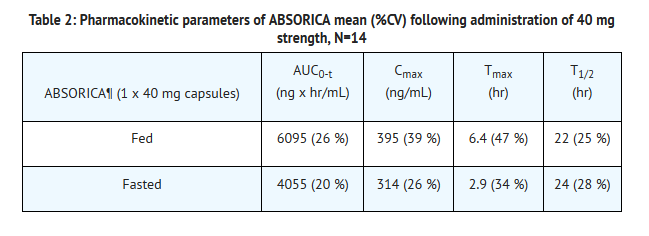
Published clinical literature has shown that there is no difference in the pharmacokinetics of isotretinoin between patients with nodular acne and healthy subjects with normal skin.
Distribution
Isotretinoin is more than 99.9% bound to plasma proteins, primarily albumin.
Metabolism
Following oral administration of isotretinoin, at least three metabolites have been identified in human plasma: 4-oxo-isotretinoin, retinoic acid (tretinoin), and 4-oxo-retinoic acid (4-oxo-tretinoin). Retinoic acid and 13-cis-retinoic acid are geometric isomers and show reversible interconversion. The administration of one isomer will give rise to the other. Isotretinoin is also irreversibly oxidized to 4-oxo-isotretinoin, which forms its geometric isomer 4-oxo-tretinoin.
After a single 40 mg oral dose of ABSORICA to 57 healthy adult subjects, concurrent administration of food increased the extent of formation of all metabolites in plasma when compared to the extent of formation under fasted conditions.
All of these metabolites possess retinoid activity that is in some in vitro models more than that of the parent isotretinoin. However, the clinical significance of these models is unknown.
In vitro studies indicate that the primary P450 isoforms involved in isotretinoin metabolism are 2C8, 2C9, 3A4, and 2B6. Isotretinoin and its metabolites are further metabolized into conjugates, which are then excreted in urine and feces.
Elimination
Following oral administration of an 80 mg dose of 14C-isotretinoin as a liquid suspension, 14C-activity in blood declined with a half-life of 90 hours. The metabolites of isotretinoin and any conjugates are ultimately excreted in the feces and urine in relatively equal amounts (total of 65% to 83%).
After a single 40 mg (2 x 20 mg) oral dose of ABSORICA to 57 healthy adult subjects under fed conditions, the mean ± SD elimination half-lives (T1/2) of isotretinoin and 4-oxo-isotretinoin under fed states were 18 hours and 38 hours, respectively.
Special Patient Populations
The pharmacokinetics of isotretinoin were evaluated after single and multiple doses in 38 pediatric patients (12 to 15 years) and 19 adult patients (≥18 years) who received isotretinoin for the treatment of severe recalcitrant nodular acne. In both age groups, 4-oxo-isotretinoin was the major metabolite; tretinoin and 4-oxo-tretinoin were also observed. There were no statistically significant differences in the pharmacokinetics of isotretinoin between pediatric and adult patients.
Nonclinical Toxicology
13.1 Carcinogenesis, Mutagenesis and Impairment of Fertility
In male and female Fischer 344 rats given oral isotretinoin at dosages of 8 or 32 mg/kg/day (1.3 to 5.3 times the recommended clinical dose of 1 mg/kg/day, respectively, after normalization for total body surface area) for greater than 18 months, there was a dose-related increased incidence of pheochromocytoma relative to controls. The incidence of adrenal medullary hyperplasia was also increased at the higher dosage in both sexes. The relatively high level of spontaneous pheochromocytomas occurring in the male Fischer 344 rat makes it an equivocal model for study of this tumor; therefore, the relevance of this tumor to the human population is uncertain.
The Ames test was conducted with isotretinoin in two laboratories. The results of the tests in one laboratory were negative while in the second laboratory a weakly positive response (less than 1.6 x background) was noted in S. typhimurium TA100 when the assay was conducted with metabolic activation. No dose response effect was seen and all other strains were negative. Additionally, other tests designed to assess genotoxicity (Chinese hamster cell assay, mouse micronucleus test, S. cerevisiae D7 assay, in vitro clastogenesis assay with human-derived lymphocytes, and unscheduled DNA synthesis assay) were all negative.
In rats, no adverse effects on gonadal function, fertility, conception rate, gestation or parturition were observed at oral dosages of isotretinoin of 2, 8, or 32 mg/kg/day (0.3, 1.3, or 5.3 times the recommended clinical dose of 1 mg/kg/day, respectively, after normalization for total body surface area).
In dogs, testicular atrophy was noted after treatment with oral isotretinoin for approximately 30 weeks at dosages of 20 or 60 mg/kg/day (10 or 30 times the recommended clinical dose of 1 mg/kg/day, respectively, after normalization for total body surface area). In general, there was microscopic evidence for appreciable depression of spermatogenesis but some sperm were observed in all testes examined and in no instance were completely atrophic tubules seen.
In trials of 66 men, 30 of whom were patients with nodular acne under treatment with oral isotretinoin, no significant changes were noted in the count or motility of spermatozoa in the ejaculate. In a study of 50 men (ages 17 to 32 years) receiving isotretinoin therapy for nodular acne, no significant effects were seen on ejaculate volume, sperm count, total sperm motility, morphology or seminal plasma fructose.
13.2 Animal Toxicology
In rats given 8 or 32 mg/kg/day of isotretinoin (1.3 to 5.3 times the recommended clinical dose of 1 mg/kg/day after normalization for total body surface area) for 18 months or longer, the incidences of focal calcification, fibrosis and inflammation of the myocardium, calcification of coronary, pulmonary and mesenteric arteries, and metastatic calcification of the gastric mucosa were greater than in control rats of similar age. Focal endocardial and myocardial calcifications associated with calcification of the coronary arteries were observed in two dogs after approximately 6 to 7 months of treatment with isotretinoin at a dosage of 60 to 120 mg/kg/day (30 to 60 times the recommended clinical dose of 1 mg/kg/day, respectively, after normalization for total body surface area).
Clinical Studies
A double-blind, randomized, parallel group trial (Study 1) was conducted in patients with severe recalcitrant nodular acne to evaluate the efficacy and safety of ABSORICA compared to a generic product of Accutane® under fed conditions. Enrolled patients had a weight of 40 to 110 kg with at least 10 nodular lesions on the face and/or trunk. A total of 925 patients were randomized 1:1 to receive ABSORICA or a generic product of Accutane® (isotretinoin). Study patients ranged from 12 to 54 years of age, were approximately 60% male, 40% female, and were 87% White, 4% Black, 6% Asian, and 3% Other. Patients were treated an initial dose of 0.5 mg/kg/day in two divided doses for the first 4 weeks followed by 1 mg/kg/day in two divided doses for the following 16 weeks.
Change from Baseline to Week 20 in total nodular lesion count and proportion of patients with at least a 90% reduction in total nodular lesion count from Baseline to Week 20 are presented in Table 3. Total nodular lesion counts by visit are presented in Figure 1.
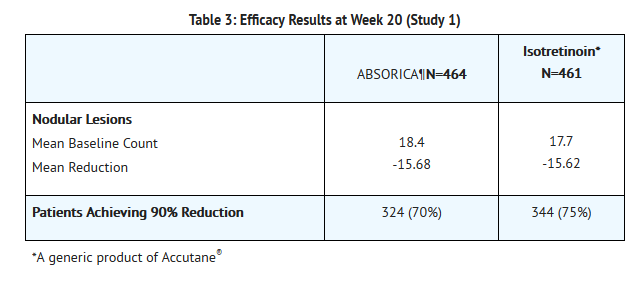
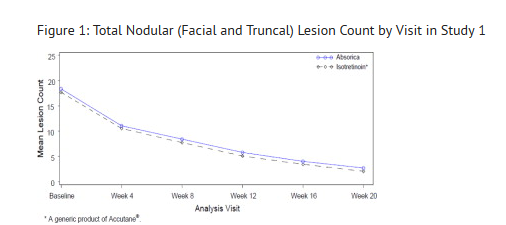
How Supplied
ABSORICA (isotretinoin) Capsules are supplied as follows:
10 mg: Dark yellow, opaque, capsule imprinted with black ink “ G 240” on cap and “ 10” on the body Box of 30 capsules (3 x 10 Prescription Packs): NDC 10631-115-31
20 mg: Red, opaque, capsule imprinted with black ink “ G 241” on cap and “ 20” on the body Box of 30 capsules (3 x 10 Prescription Packs): NDC 10631-116-31
25 mg: Green, opaque, capsule imprinted with white ink “ G 342” on cap and “ 25” on the body Box of 30 capsules (3 x 10 Prescription Packs): NDC 10631-133-31
30 mg: Brown, opaque, capsule imprinted with white ink “ G 242” on cap and “ 30” on the body Box of 30 capsules (3 x 10 Prescription Packs): NDC 10631-117-31
35 mg: Dark blue, opaque, capsule imprinted with white ink “ G 343” on cap and “ 35” on the body Box of 30 capsules (3 x 10 Prescription Packs): NDC 10631-134-31
40 mg: Brown and red, capsule imprinted with white ink “ G 325” on cap and “ 40” on the body Box of 30 capsules (3 x 10 Prescription Packs): NDC10631-118-31
Storage
Store at 20° C - 25° C (68° F - 77° F), excursion permitted between 15° C - 30° C (59° F - 86° F) [see USP controlled room temperature]. Protect from light.
Images
Drug Images
{{#ask: Page Name::Isotretinoin |?Pill Name |?Drug Name |?Pill Ingred |?Pill Imprint |?Pill Dosage |?Pill Color |?Pill Shape |?Pill Size (mm) |?Pill Scoring |?NDC |?Drug Author |format=template |template=DrugPageImages |mainlabel=- |sort=Pill Name }}
Package and Label Display Panel
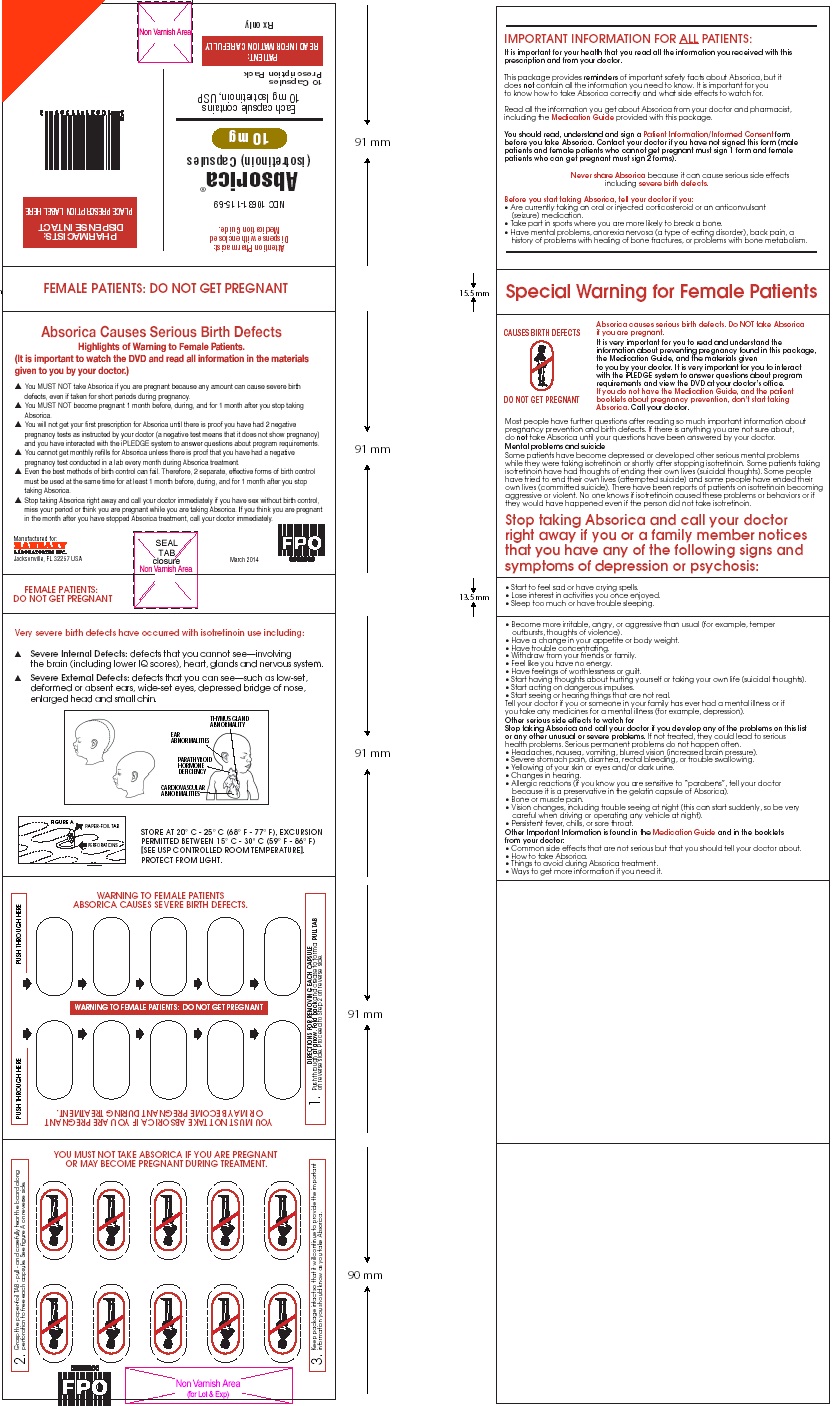
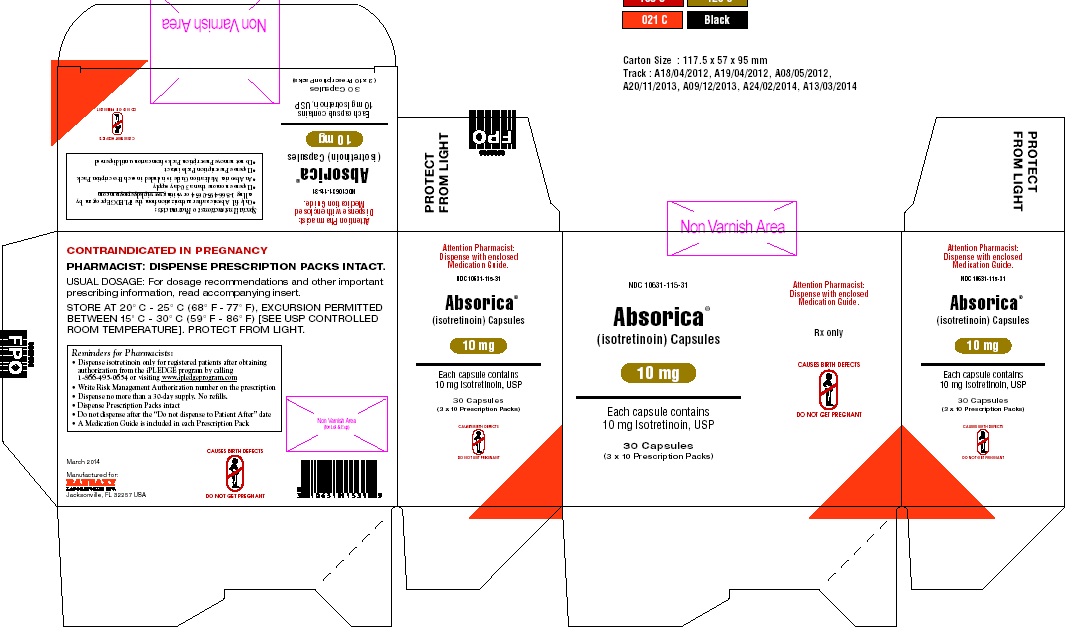
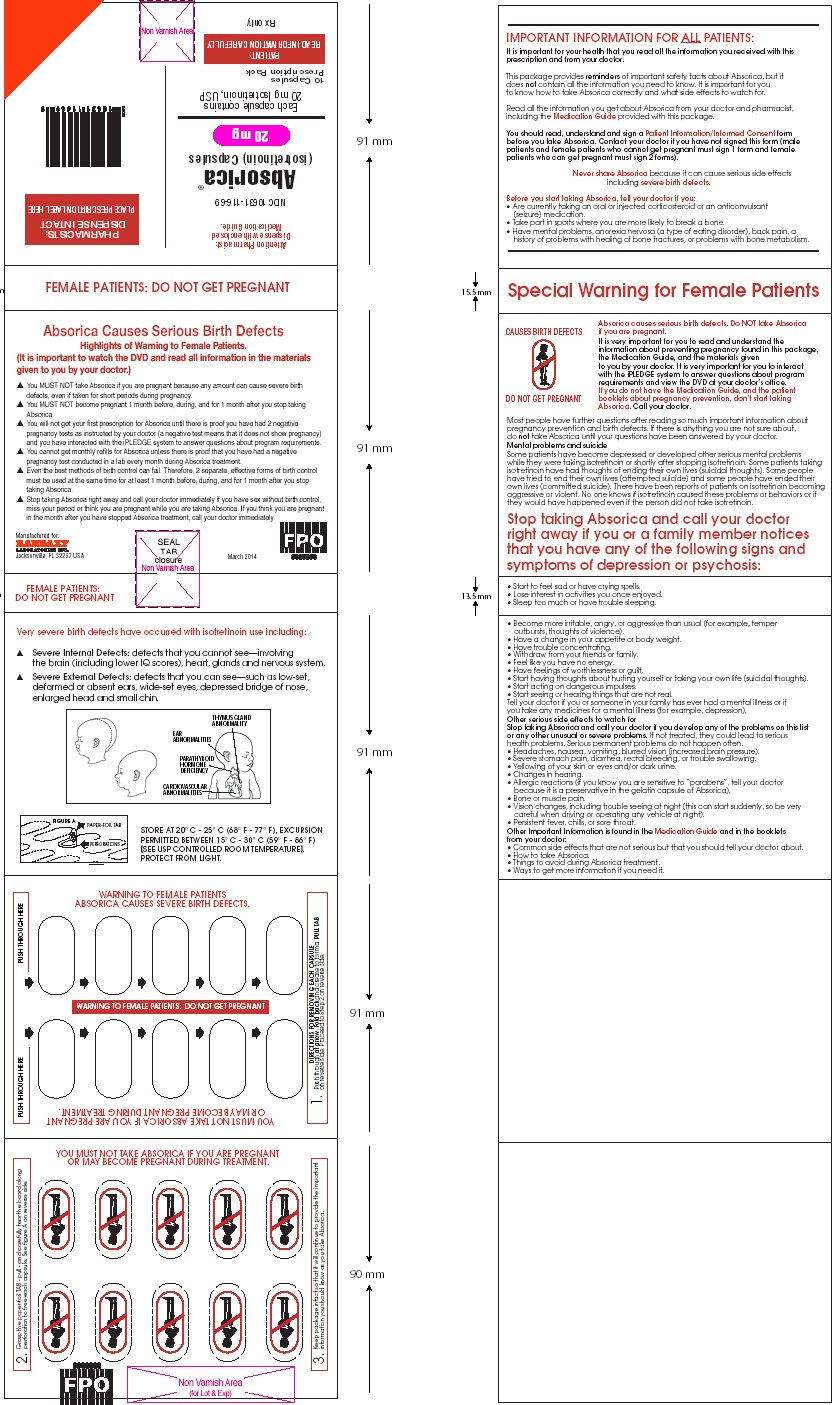
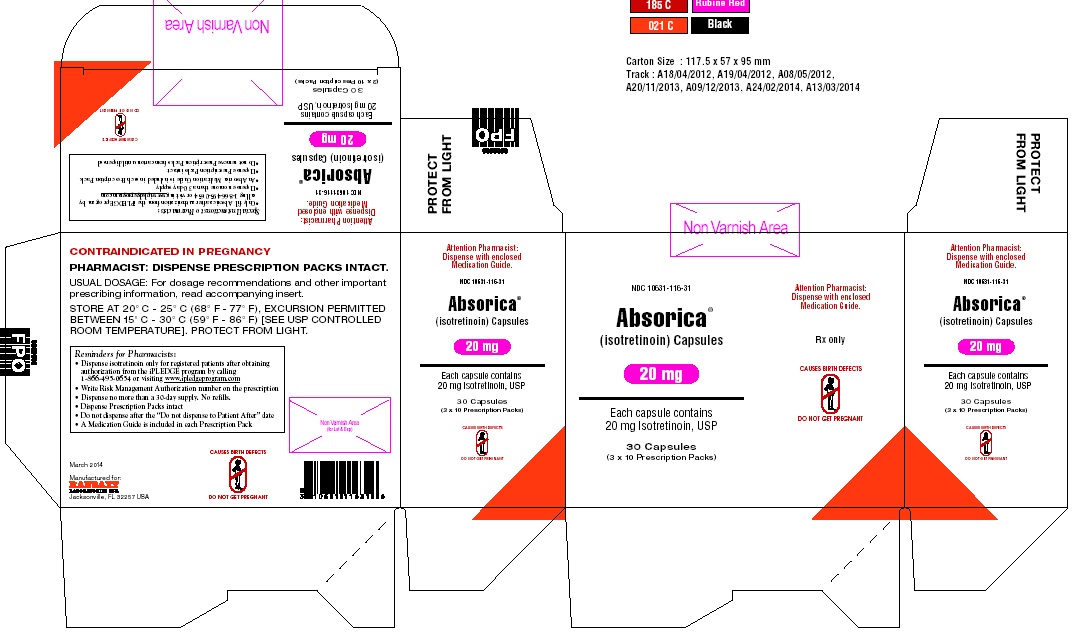
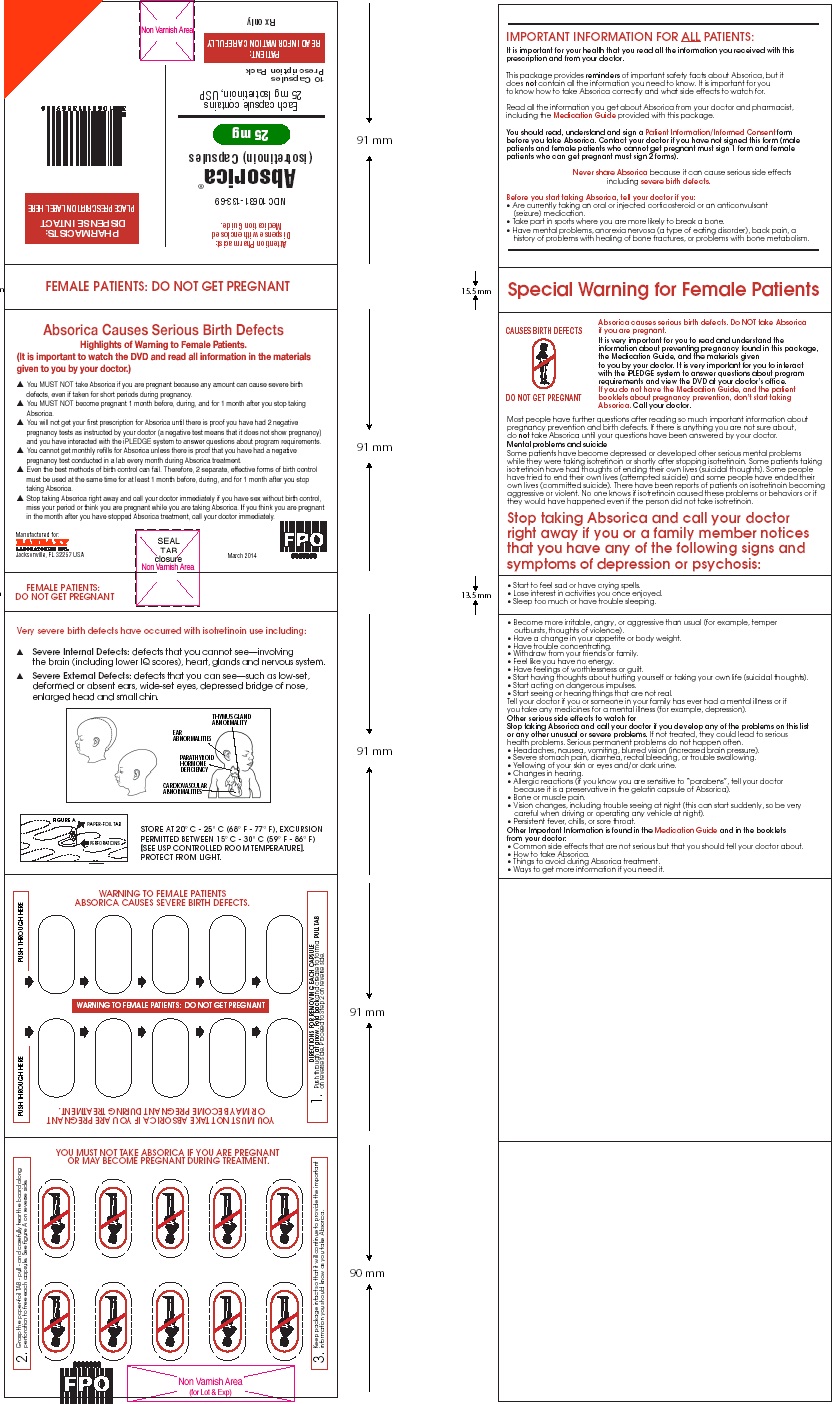
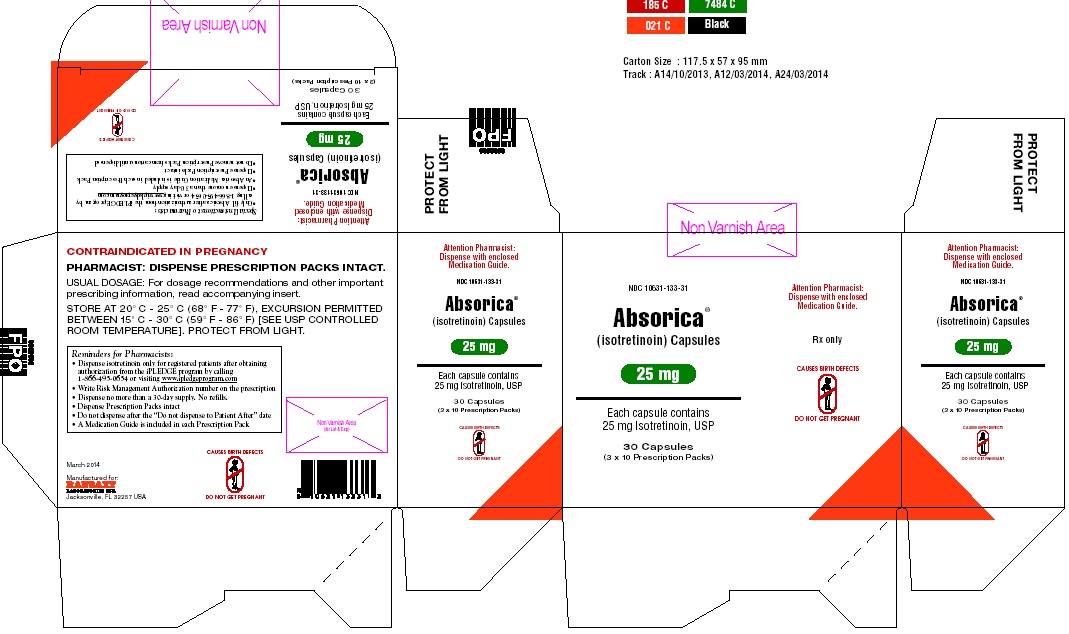

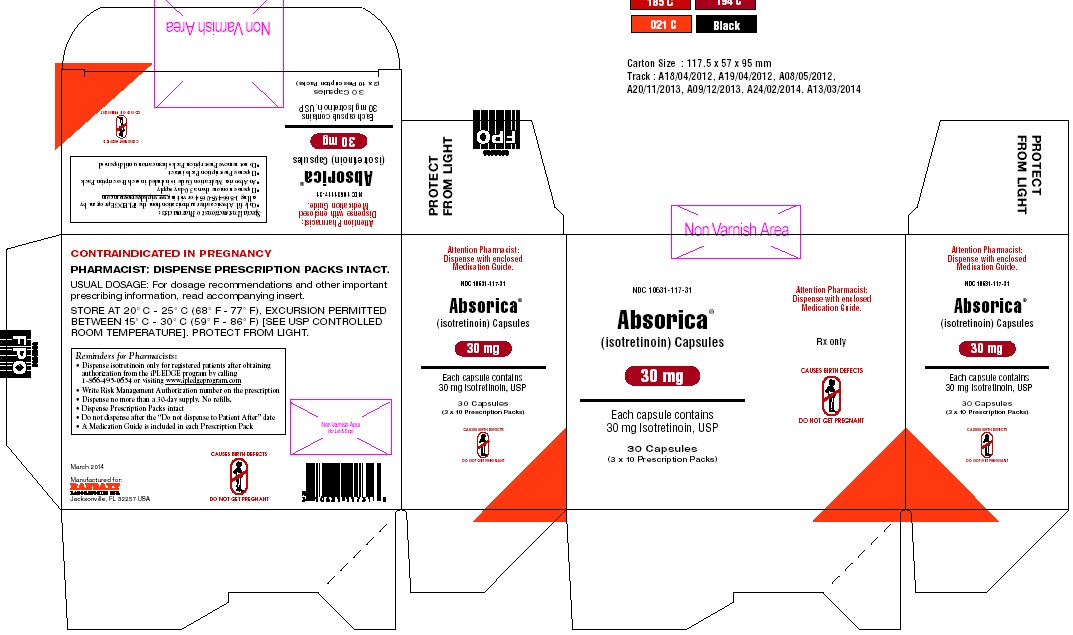
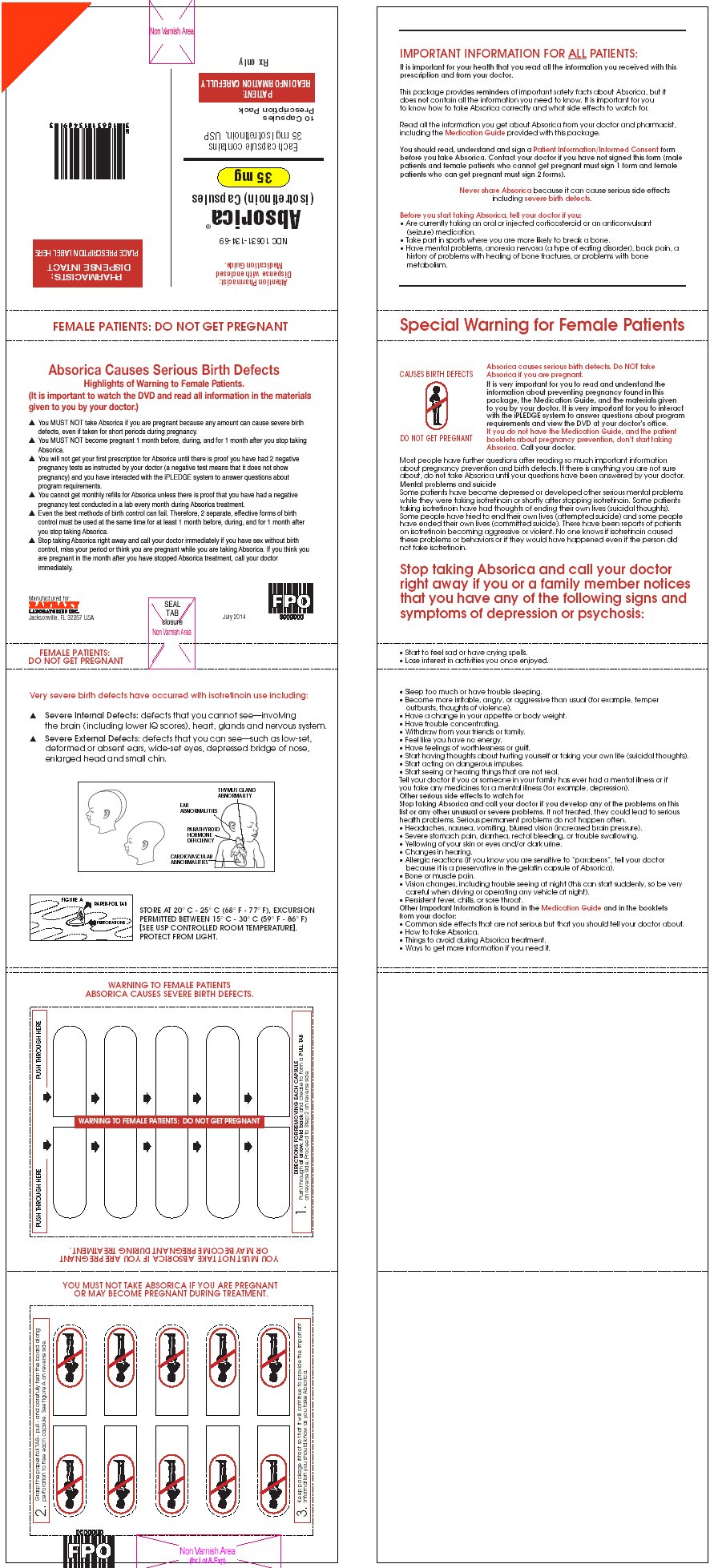
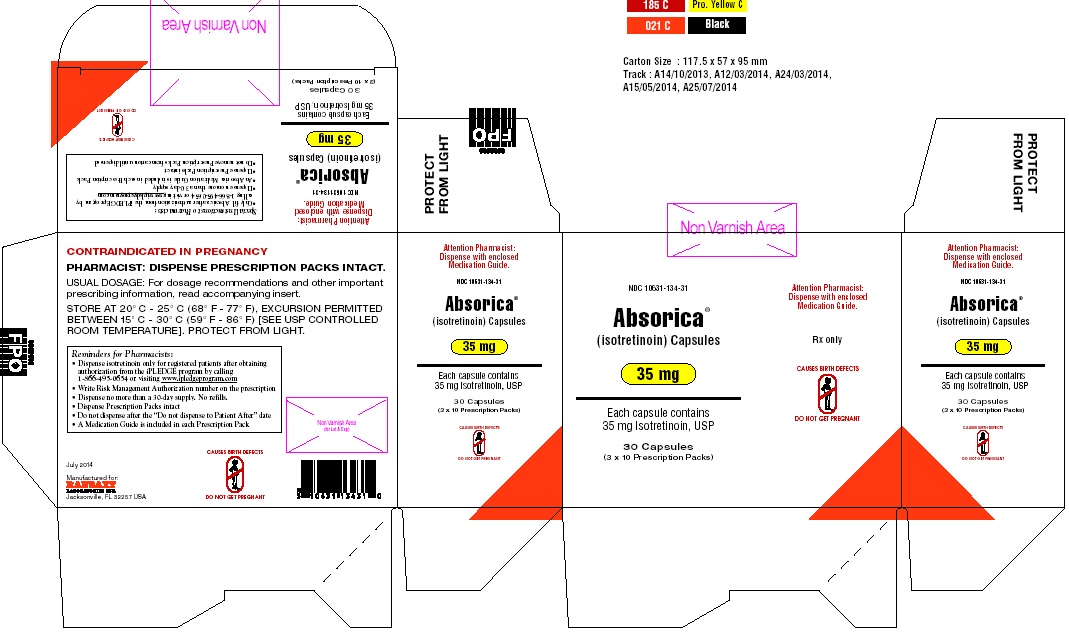
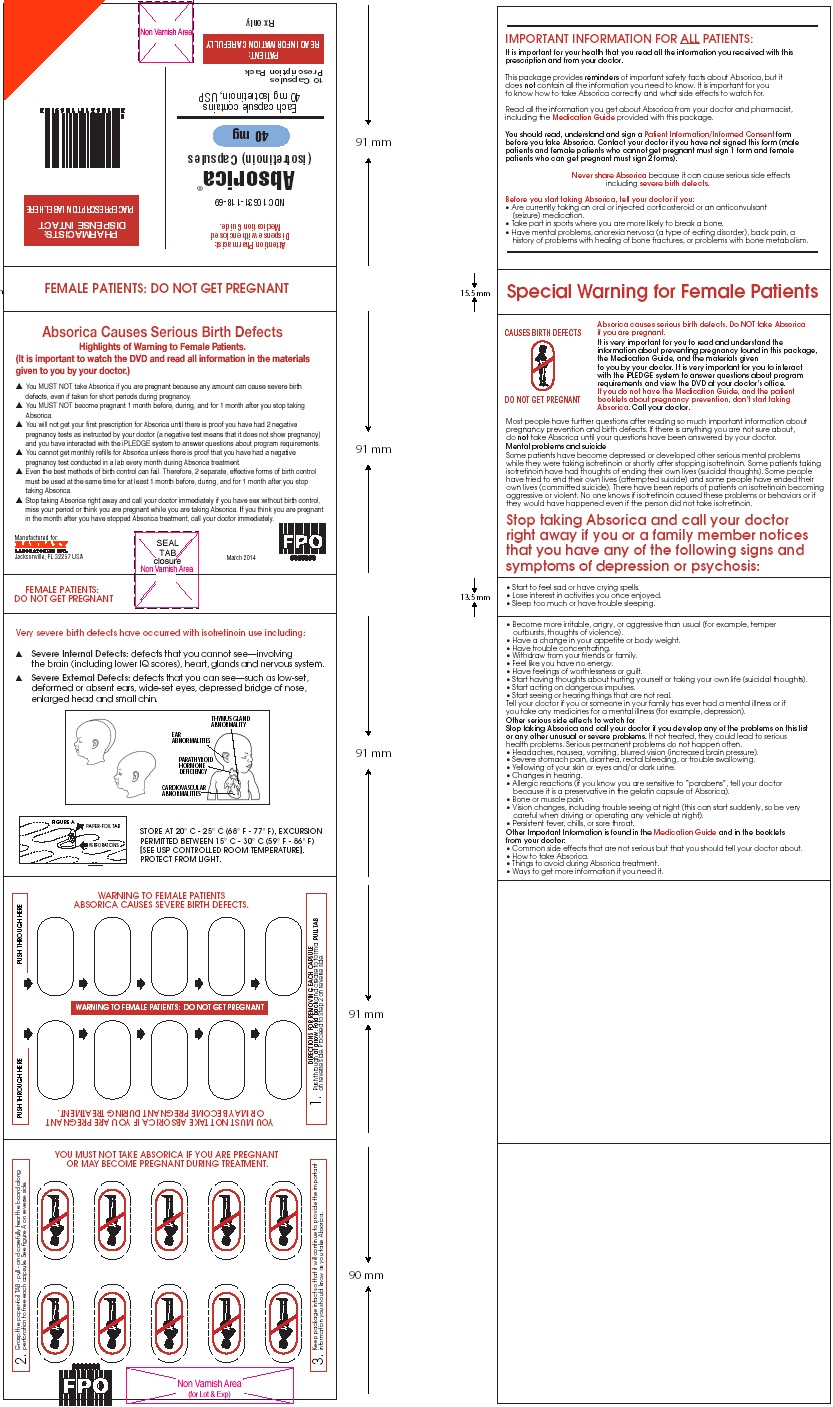
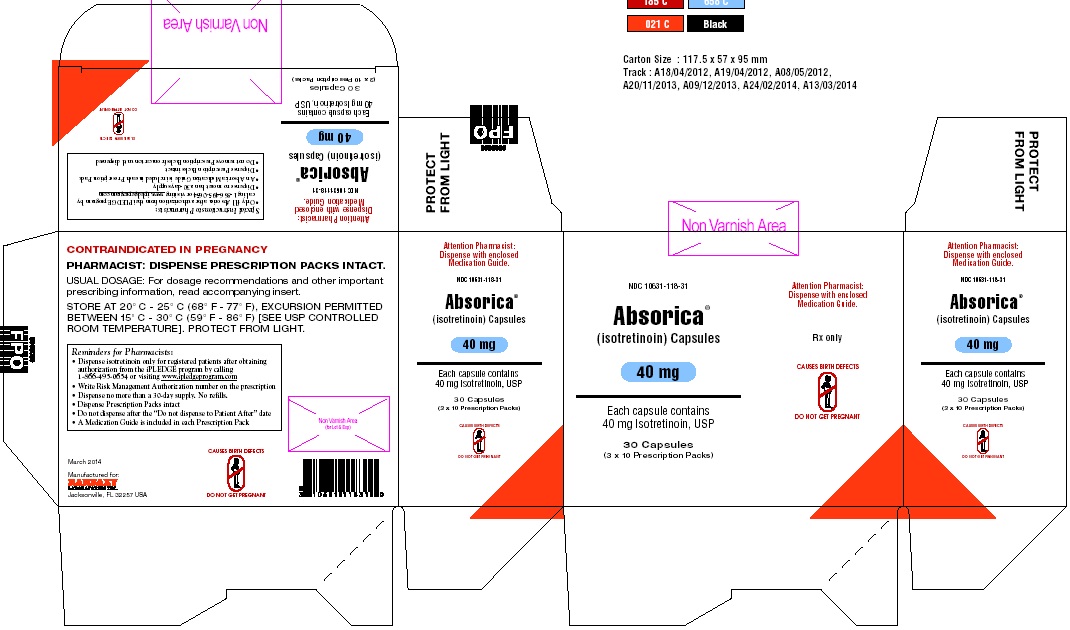

{{#ask: Label Page::Isotretinoin |?Label Name |format=template |template=DrugLabelImages |mainlabel=- |sort=Label Page }}
Patient Counseling Information
Advise the patient that ABSORICA is only available through a restricted program called iPLEDGE.
As a component of the iPLEDGE program, prescribers must instruct patients to read the Medication Guide, the iPLEDGE program patient educational booklets, and watch the DVD with the following videos — “Be Prepared, Be Protected” and “Be Aware: The Risk of Pregnancy While on Isotretinoin”. The DVD includes information about contraception, the most common reasons that contraception fails, and the importance of using 2 forms of effective contraception when taking teratogenic drugs and comprehensive information about types of potential birth defects which could occur if a female patient who is pregnant takes ABSORICA at any time during pregnancy. Male patients and Female patients not of childbearing potential must understand the risks and benefits of ABSORICA, comply with the REMS requirements described in the booklet entitled The iPLEDGE Program Guide to Isotretinoin for Male Patients and Female Patients Who Cannot Get Pregnant, and sign a Patient Information/Informed Consent form. Female patients of childbearing potential must be instructed that they must not be pregnant when ABSORICA therapy is initiated or plan to become pregnant while receiving ABSORICA therapy. Additionally, they must use 2 forms of effective contraception simultaneously for 1 month before starting ABSORICA, while taking ABSORICA, and for 1 month after ABSORICA has been stopped, unless they commit to continuous abstinence from heterosexual intercourse. They should also sign a Patient Information/Informed Consent form and Patient Information/Informed Consent About Birth Defects (for female patients who can get pregnant) form prior to beginning ABSORICA therapy. Female patients should be seen by their prescribers monthly and have a urine or serum pregnancy test, in a CLIA-certified laboratory, performed each month during treatment to confirm negative pregnancy status before another ABSORICA prescription is written. Additionally, a pregnancy test must be completed at the end of the entire course of ABSORICA therapy and 1 month after discontinuation of therapy. Advise the patient that isotretinoin is found in the semen of male patients taking isotretinoin, but the amount delivered to a female partner would be about one million times lower than an oral dose of 40 mg. While the no-effect limit for isotretinoin induced embryopathy is unknown, 20 years of post-marketing reports include four with isolated defects compatible with features of retinoid exposed fetuses; however two of these reports were incomplete and two had other possible explanations for the defects observed. Advise the patient that ABSORICA is available only from pharmacies that are certified in the iPLEDGE program, and provide them with the telephone number (1-866-495-0654) and website ( www.ipledgeprogram.com) for information on how to obtain. Advise patients that they may be requested to participate in a survey to evaluate the effectiveness of the iPLEDGE program. Prescribers should be alert to the warning signs of psychiatric disorders to guide patients to receive the help they need. Therefore, prior to initiation of ABSORICA treatment, patients and family members should be asked about any history of psychiatric disorder, and at each visit during treatment patients should be assessed for symptoms of depression, mood disturbance, psychosis, or aggression to determine if further evaluation may be necessary. Inform patients that symptoms of depression include sad mood, hopelessness, feelings of guilt, worthlessness or helplessness, loss of pleasure or interest in activities, fatigue, difficulty concentrating, change in sleep pattern, change in weight or appetite, suicidal thoughts or attempts, restlessness, irritability, acting on dangerous impulses, and persistent physical symptoms unresponsive to treatment. Patients should stop treatment and the patient or a family member should promptly contact their prescriber if the patient develops depression, mood disturbance, psychosis, or aggression, without waiting until the next visit. Discontinuation of ABSORICA treatment may be insufficient; further evaluation may be necessary. While such monitoring may be helpful, it may not detect all patients at risk. Patients may report mental health problems or family history of psychiatric disorders. These reports should be discussed with the patient and/or the patient's family. A referral to a mental health professional may be necessary. The physician should consider whether ABSORICA therapy is appropriate in this setting; for some patients the risks may outweigh the benefits of ABSORICA therapy. Patients must be informed that some patients, while taking isotretinoin or soon after stopping isotretinoin, have become depressed or developed other serious mental problems. Symptoms of depression include sad, “anxious” or empty mood, irritability, acting on dangerous impulses, anger, loss of pleasure or interest in social or sports activities, sleeping too much or too little, changes in weight or appetite, school or work performance going down, or trouble concentrating. Some patients taking isotretinoin have had thoughts about hurting themselves or putting an end to their own lives (suicidal thoughts), some have tried to end their own lives, and some have ended their own lives. There were reports that some of these people did not appear depressed. There have been reports of patients on isotretinoin becoming aggressive or violent. There have also been reports of psychotic symptoms, which indicate a loss of contact with reality. Psychotic symptoms include feelings of suspiciousness toward others, strange beliefs, hearing voices or other noises without an obvious source, and seeing unusual objects or people with no explanation. No one knows if isotretinoin caused these behaviors and symptoms or if they would have happened even if the person did not take isotretinoin. If any of these behaviors or symptoms occur, the patient should stop treatment and the patient or family member should contact the prescriber promptly without waiting until the next visit [ see Warnings and Precautions (5.4)]. Some people have had other signs of depression while taking isotretinoin. Patients must be informed that they must not share ABSORICA with anyone else because of the risk of birth defects and other serious adverse reactions. Patients must be informed not to donate blood during therapy and for 1 month following discontinuation of the drug because the blood might be given to a pregnant female patient whose fetus must not be exposed to ABSORICA. ABSORICA may be taken without regard to meals [ see Dosage and Administration (2.1)]. To decrease the risk of esophageal irritation, patients should swallow the capsules with a full glass of liquid. Patients should be informed that inflammatory bowel disease (including regional ileitis) may occur without a prior history of intestinal disorders. In rare instances, symptoms have been reported to persist after treatment has stopped. Patients should be informed that if they experience abdominal pain, rectal bleeding or severe diarrhea, they should discontinue ABSORICA immediately. Patients should be informed that transient exacerbation (flare) of acne has been seen, generally during the initial period of therapy. Wax epilation and skin resurfacing procedures (such as dermabrasion, laser) should be avoided during ABSORICA therapy and for at least 6 months thereafter due to the possibility of scarring. Patients should be advised to avoid prolonged exposure to UV rays or sunlight. Patients should be informed that they may experience dry eye, corneal opacities, and decreased night vision. Contact lens wearers may experience decreased tolerance to contact lenses during and after therapy. Patients should be informed that 16% of patients treated with isotretinoin in a clinical trial developed musculoskeletal symptoms (including arthralgia) during treatment. In general, these symptoms were mild to moderate, but occasionally required discontinuation of the drug. Transient pain in the chest has been reported less frequently. In the clinical trial, these symptoms generally cleared rapidly after discontinuation of therapy, but in some cases persisted. There have been rare postmarketing reports of rhabdomyolysis, some associated with strenuous physical activity. Pediatric patients and their caregivers should be informed that approximately 17% to 29% of pediatric patients treated with isotretinoin developed back pain. In a clinical trial, back pain was severe in 13.5% of the cases and occurred at a higher frequency in female patients than male patients. Arthralgias were experienced in 22% (79/358) of pediatric patients. Arthralgias were severe in 7.6% (6/79) of patients. Appropriate evaluation of the musculoskeletal system should be done in patients who present with these symptoms during or after a course of treatment. Consideration should be given to discontinuation of isotretinoin if any significant abnormality is found. Neutropenia and rare cases of agranulocytosis have been reported in patients treated with isotretinoin. ABSORICA should be discontinued if clinically significant decreases in white cell counts occur. Patients should be advised that severe skin reactions (Stevens-Johnson syndrome and toxic epidermal necrolysis) have been reported in post marketing data in patients treated with isotretinoin. Treatment with ABSORICA should be discontinued if clinically significant skin reactions occur. Adolescent patients who participate in sports with repetitive impact should be informed that isotretinoin use may increase their risk of spondylolisthesis or hip growth plate injuries. There are spontaneous reports of fractures and/or delayed healing in patients while on therapy with isotretinoin or following cessation of therapy with isotretinoin while involved in these activities [ see Warnings and Precautions (5.12)].

Precautions with Alcohol
- Alcohol-Isotretinoin interaction has not been established. Talk to your doctor about the effects of taking alcohol with this medication.
Brand Names
Accutane, Amnesteem, Claravis, Sotret, Myorisan, Absorica.
Look-Alike Drug Names
- A® — B®[1]
Drug Shortage Status
Price
References
The contents of this FDA label are provided by the National Library of Medicine.
- ↑ "http://www.ismp.org". External link in
|title=(help)
{{#subobject:
|Page Name=Isotretinoin
|Pill Name=No image.jpg
|Drug Name=
|Pill Ingred=|+sep=;
|Pill Imprint=
|Pill Dosage={{{dosageValue}}} {{{dosageUnit}}}
|Pill Color=|+sep=;
|Pill Shape=
|Pill Size (mm)=
|Pill Scoring=
|Pill Image=
|Drug Author=
|NDC=
}}
{{#subobject:
|Label Page=Isotretinoin |Label Name=Isotretinoin11.png
}}
{{#subobject:
|Label Page=Isotretinoin |Label Name=Isotretinoin11.png
}}